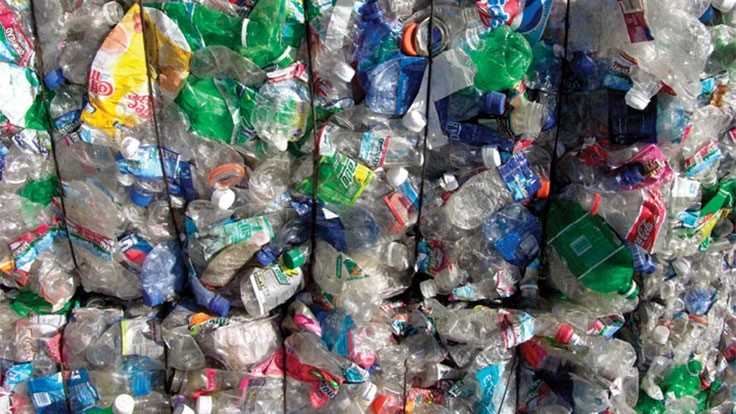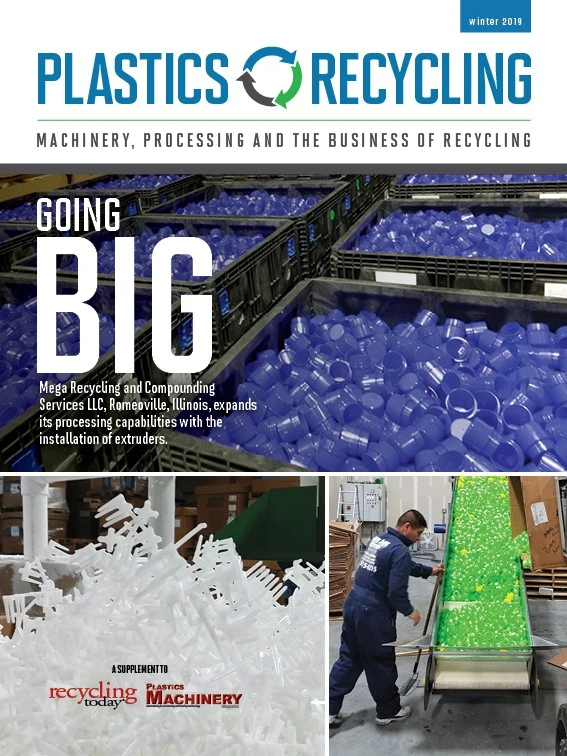
Alan Crosthwaite / dreamstime.com
_(002)_fmt.png)
Nestlé Waters North America (NWNA), Stamford, Connecticut, has committed to using 25 percent recycled plastic across its U.S. domestic portfolio by 2021 and 50 percent by 2025. The company also has committed to making 100 percent of its packaging recyclable or reusable by 2025. But before NWNA can reach these goals, representatives from the company say increasing recycled polyethylene terephthalate (rPET) supply will be necessary. NWNA is doing its part to help.
In December 2018, NWNA announced that it is expanding its relationship with key rPET supplier Plastrec Inc. of Joliette, Quebec, in addition to working with other suppliers to support its ability to nearly quadruple its use of food-grade rPET in less than three years. In November 2018, the company announced the expansion of its partnership with CarbonLite Industries LLC as the Los Angeles-based rPET supplier builds a third U.S. facility in the Lehigh Valley area of Pennsylvania, where NWNA has a bottling facility.
In a press release announcing the expanded relationship with Plastrec, Fernando Mercé, president and CEO of NWNA, says, “We want to take the ‘single’ out of ‘single-use’ bottles. Our bottles were never meant to be thrown in the garbage—we carefully design them to be collected, recycled and repurposed.”
Reduce and recycle
Before it began incorporating rPET into its water bottles in 2010, NWNA reduced the amount of plastic used in its packaging. Since 1994, the company has decreased the PET content of its half-liter water bottles by more than 60 percent through lightweighting, says Pia Baker, NWNA group marketing manager.
The company says it saves approximately 65 million pounds of PET annually by lightweighting its bottles, for a total savings of 5 billion pounds as of 2017.
“Using more recycled content was a natural progression,” Baker says.
“I believe our early use of recycled plastic has helped us build and maintain brand love,” she continues. “Increasingly, consumers are actively trying to change their own habits to decrease impact on the environment—and that includes supporting brands that are committed to sustainability. We are building brand affinity among our consumers while tackling environmental impacts.”
Valeria Orozco, NWNA director of sustainability, says China’s National Sword policy further highlights the need for domestic recycling opportunities.
In early 2018, NWNA says it reached a company milestone when it introduced a 700-milliliter Nestlé Pure Life bottle made entirely from rPET. Prior to that, in 2017, 9 out of every 10 of the company’s Arrowhead brand spring water bottles were made with 50 percent recycled content. NWNA says it also is expanding its overall use of rPET by nearly 40 percent for its Arrowhead brand, which equals 18 million pounds of recycled material annually.
The company has made considerable progress in its rPET use in California, Baker says, noting that the bottles it sells in this market contain an average of 42 percent rPET.
“California has been a great market for us because of its high recycling rate and established recycling infrastructure,” she says. “We use twice as much recycled content as any competitor in California.”
Orozco says NWNA historically has used 12-month rPET supply contracts, understanding that it is difficult for recyclers to invest in equipment and labor without such commitments.
NWNA works to develop its rPET suppliers by first understanding where they are and what kind of equipment they have, she says. The company also asks about the source of their feedstock—whether it is bottle bill or curbside material—and shares what it is looking for in its rPET supply.
"Nestlé Waters is setting the example that the rest of the beverage industry must embrace." – Mark Murray, Californians Against Waste
“We are looking for ways to increase recycled content use wherever possible,” Baker says.
NWNA also is looking beyond rPET, Orozco says, mentioning a bio-based bottle the company is developing in partnership with Danone as well as NWNA’s interest in chemically recycling plastics. She says depolymerization can offer many advantages, particularly in the area of quality. “Stripping PET back down to its basic elements means we may get higher quality material than what can currently be accomplished with traditional mechanical recycling.”
Orozco adds that chemical recycling could apply to materials such as textiles, carpet and colored bottles that can be difficult to recycle.

Raising awareness
To achieve its recycled content goals, Orozco says some of the issues and obstacles the company faces must be addressed.
“Specifically,” she says, “we are facing a matter of supply,” which is amplified by the company’s need to use food-grade quality rPET.”
Orozco says NWNA is taking action to address rPET supply by investing in the Closed Loop Fund, New York City. The bottled water company has invested $6 million in the $100 million social impact investment fund that finances recycling infrastructure projects and community recycling programs.
In municipalities such as Waterbury, Connecticut, the Closed Loop Fund is supporting enhanced recycling programs with a goal of increasing the current city recycling rate from 6 percent to 25 percent by 2020. In late 2018, the Closed Loop Fund announced a $1.5 million investment in rPlanet Earth, Vernon, California, a vertically integrated manufacturer of rPET packaging.
Additionally, consumer education is critical to increasing rPET supply, Baker says. “We need that supply of food-grade PET, and we need consumers to recycle the right way.”
_fmt.png)
The company has incorporated the How2Recycle label on its major bottled water brands. This standardized label is designed to clearly communicate recycling instructions to consumers.
Through its regional spring water brand Zephyrhills, NWNA also partners with Keep America Beautiful in Florida to distribute recycling bins and increase recycling access at beaches and other public recreation areas, Baker says. “The project captured 60,000 pounds of recyclables in its first year and showed 32 percent improvement in litter index scores,” she adds. “We also wanted to reinforce the value that recyclables have, so we installed bike racks and benches made from recycled plastic for the local communities to use and enjoy.”
“Recovering plastic bottles is one of our highest priorities,” the NWNA website states. “Failing to do so means plastic ends up in landfills, natural areas and our oceans, and we are committed to doing our part to solve the problem. One of the most important actions we can take to increase recovery is teaching people how to recycle.”
Orozco says the company tries to educate consumers on the environmental impacts of their recycling efforts. “Our consumers have the power to prevent valuable plastic materials from being discarded. We will continue to work to inspire our consumers and advance recycling policies so that we can capture and reuse as many PET beverage containers as possible.”
Design for recycling
Baker says using recycled content is the “right thing to do from a sustainability perspective” as well as from a consumer preference perspective. She cites 2018 research that shows 47 percent of consumers are influenced by environmentally friendly packaging in the beverage industry.
Orozco adds that the importance extends beyond consumers as governments become increasingly interested in issues created by single-use plastics. “Our bottle was not meant to be thrown away but to be used again,” she says. “A bottle made from another bottle is not single-use.”
Ensuring adequate rPET supply begins with NWNA’s bottle designs. “We are doing ourselves a disservice if we can’t recycle our products,” Baker says, adding that the company follows Association of Plastic Recyclers, Washington, and European PET Bottle Platform guidelines.
“We also have very strong internal expertise around designing with recyclability in mind,” she adds. “In fact, it’s become common for our marketing team members to participate in full-day recycling tours to really understand the journey of a plastic bottle—I’ve been on the tour twice in the past two years. We see the process from collection to sorting to baling to flaking to pelletizing. It really reinforces the important role we play in designing bottles.”
“Through long-term supplier contracts and our commitment to supporting initiatives to improve collection rates, we are helping to stimulate a more robust recycling market and unlock the potential of a circular economy here in the U.S.,” Mercé says.
“If plastic is going to survive as a packaging material, it must demonstrate closed loop capability,” says Mark Murray, executive director of the environmental group Californians Against Waste. “Nestlé Waters has embraced this responsibility by accelerating their use of recycled content over the next three years and their commitment to reach 50 percent by 2025. Nestlé Waters is setting the example that the rest of the beverage industry must embrace.”

Explore the February 2019 Plastics Recycling Issue
Check out more from this issue and find your next story to read.
Latest from Recycling Today
- BMW Group, Encory launch 'direct recycling’ of batteries
- Loom Carbon, RTI International partner to scale textile recycling technology
- Goodwill Industries of West Michigan, American Glass Mosaics partner to divert glass from landfill
- CARI forms federal advocacy partnership
- Monthly packaging papers shipments down in November
- STEEL Act aims to enhance trade enforcement to prevent dumping of steel in the US
- San Francisco schools introduce compostable lunch trays
- Aduro graduates from Shell GameChanger program





